G.Skill Phoenix Blade (480GB) PCIe SSD Review
by Kristian Vättö on December 12, 2014 9:02 AM ESTRandom Read/Write Speed
The four corners of SSD performance are as follows: random read, random write, sequential read and sequential write speed. Random accesses are generally small in size, while sequential accesses tend to be larger and thus we have the four Iometer tests we use in all of our reviews.
Our first test writes 4KB in a completely random pattern over an 8GB space of the drive to simulate the sort of random access that you'd see on an OS drive (even this is more stressful than a normal desktop user would see). We perform three concurrent IOs and run the test for 3 minutes. The results reported are in average MB/s over the entire time.
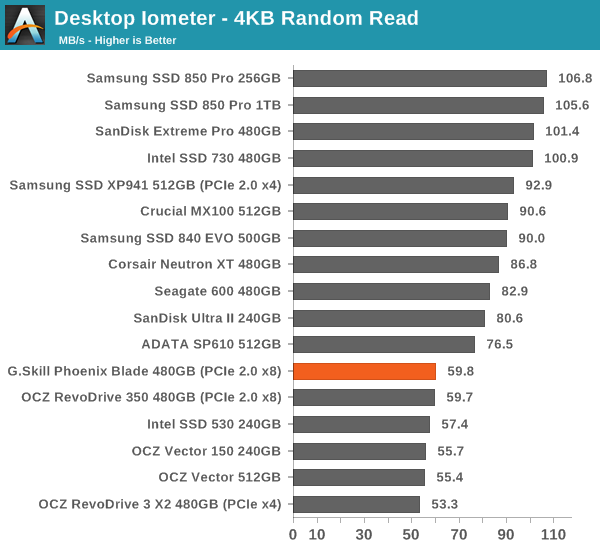
Random read speed is typical SandForce, which makes sense because the performance doesn't scale across multiple controllers at such low queue depths (QD=3 in this case).
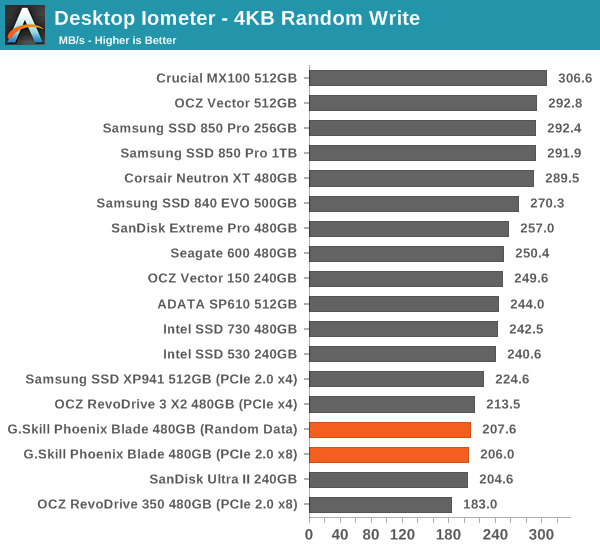
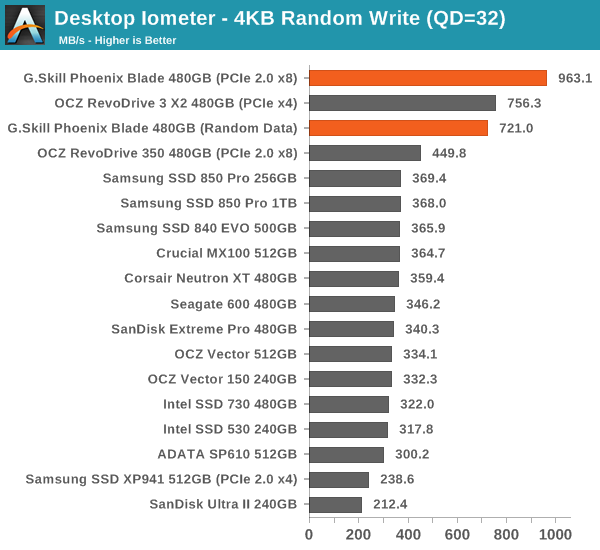
The same goes for random write performance at queue depth of 3, which isn't very high but is normal for SandForce based drives. However, the Phoenix Blade scales brilliantly with the queue depth and is considerably faster than the XP941 or RevoDrive 350.
Sequential Read/Write Speed
To measure sequential performance we run a 1 minute long 128KB sequential test over the entire span of the drive at a queue depth of 1. The results reported are in average MB/s over the entire test length.

Sequential performance is also excellent, although the XP941 enjoys a slight advantage in sequential read performance. Overall the Phoenix Blade seems to be well optimized for parallelism -- much better than the RevoDrive 350 -- as it's able to provide substantially higher performance than SATA drives.
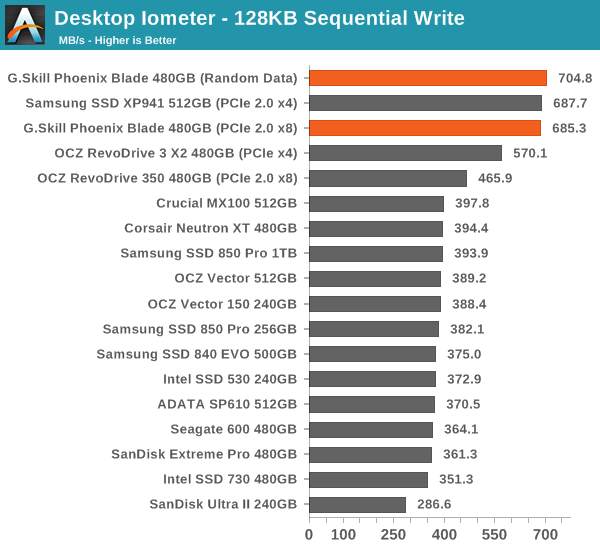
AS-SSD Incompressible Sequential Read/Write Performance
The AS-SSD sequential benchmark uses incompressible data for all of its transfers. The result is a pretty big reduction in sequential write speed on SandForce based controllers, but most other controllers are unaffected.
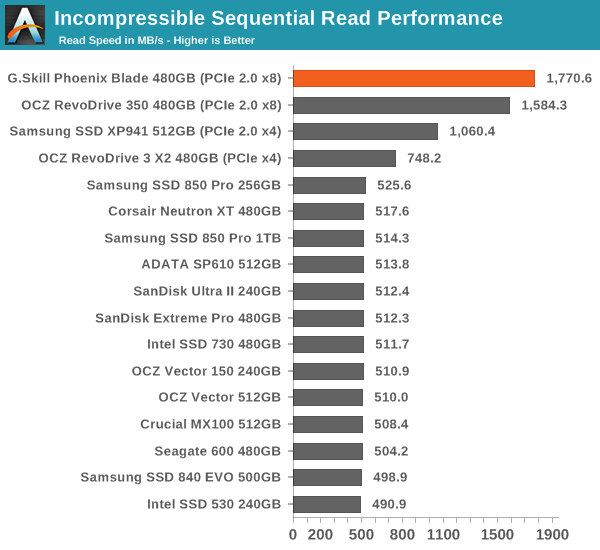
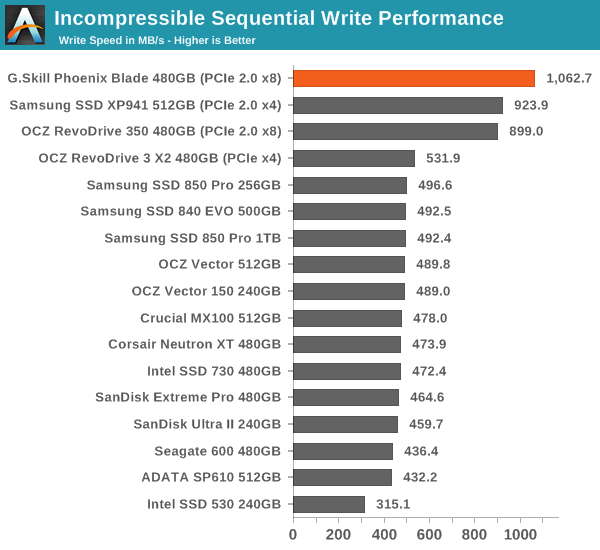










62 Comments
View All Comments
MTEK - Friday, December 12, 2014 - link
Don't really care about a RAID-0 hack. Where are the SF-3700 based SSDs? Anand/Kingston were teasing us with one from last CES.... Where is it??counterclockwork - Friday, December 12, 2014 - link
In case anyone is wondering, Kristian is wrong about the controller. SBC Designs has nothing to do with this thing, as if their website's lack of specifics and all-around amateurs-from-the-'90s look wasn't a big tip-off. Pure googling actually turns up Comay, and Comay is a brand used by CoreRise. In fact, the Phoenix Blade is nothing more than a rebadge of CoreRise's BladeDrive G24 (see http://www.corerise.com/en/product_show.php?id=95 ). Looking at the text strings in the driver for this confirms as much. As for the chip itself, CoreRise claims the SBC208 is their own proprietary device. Personally, I don't believe this, as their product portfolio doesn't otherwise suggest they have that level of expertise. I'd guess it's a LSI or Marvell controller.Kristian Vättö - Saturday, December 13, 2014 - link
Thanks for the heads up and detective work. I couldn't find anything in Google, but looks like I wasn't trying hard enough... Anyway, I've updated the article.StrongDC - Saturday, December 13, 2014 - link
The text says driven by four SandForce SF-2281 controllers while the table says 4x SandForce SF-2282. :)Kristian Vättö - Saturday, December 13, 2014 - link
Fixed :)SanX - Saturday, December 13, 2014 - link
Stop bending common sense with all that slow self-destructive flash junk and start making battery backuped RAM PCIe drives. Speeds will be 20x immediately and forever. RAM prices will drop with adoptionSanX - Saturday, December 13, 2014 - link
Battery and hard drive/flash backupFunBunny2 - Saturday, December 13, 2014 - link
Texas Memory (now, a unit of IBM) made such from 20 years ago; they were among the pioneers of SSD before NAND. Didn't sell all that well. Kind of expensive.Antronman - Saturday, December 13, 2014 - link
To be fair, that was 20 years ago.If anybody were interested, it might be $500 for an 80GB DDR3 storage drive. But honestly, nobody could utilize that sort of performance except for the largest and busiest data centers. And even they don't need it.
If you really want "teh supr speedi as f*ck spid" then you might as well just grab X79 or X99, and put in 64GBs of RAM and just ramdisk most of it.
incx - Sunday, December 14, 2014 - link
First of all you'd want proper ECC RAM on that thing, which will cost at least around $500 for the RAM only. In addition to that you'd want additional logic that will drive the whole thing, map and avoid bad chips, store stuff in flash (another cost) when power dies and resume it after, check and manage the flash, check and manage the battery and make it look like a "drive" in general. Then you add in the R&D costs, manufacturing, support and warranty costs etc and you're not even in the neighborhood any more.Creating a persistent RAM "disk" is not quite the same thing as software-mapping a bunch of consumer-grade RAM into a ramdisk. Sure, that works and is quite awesome, but everyone who uses it for anything decent, acknowledges and works around the risks that the data there may go poof or worse, bad, at any random time.